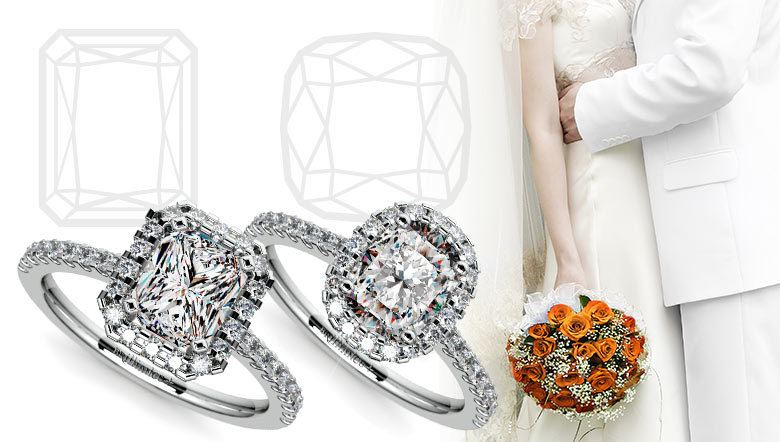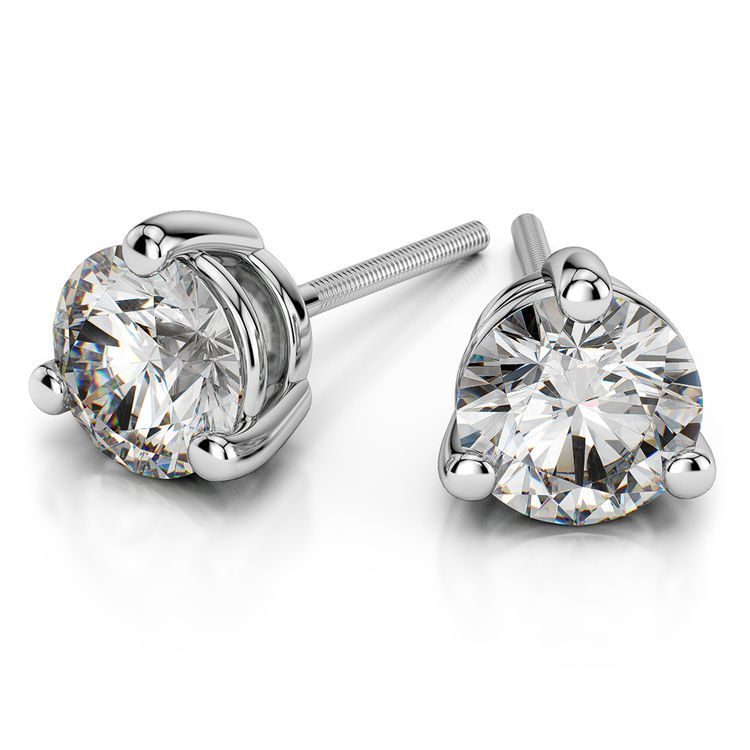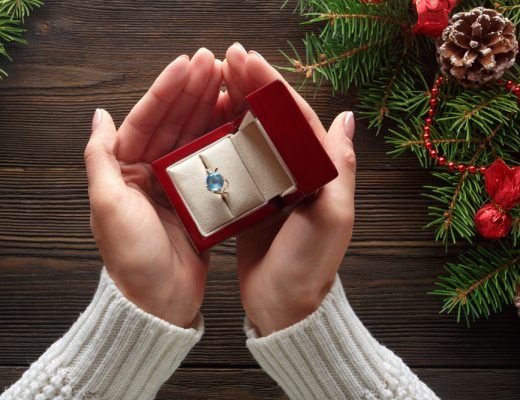Radiant vs. cushion cut diamonds: They have quite a few similarities, so which one should you choose? When you begin the process of selecting a diamond engagement ring, you may very well find yourself debating between these two popular cuts. Here, we take a close look at the differences between radiant and cushion cut diamonds, along with some similarities. Our hope is that once you finish reading, you will be better prepared to select the diamond of your dreams.
Radiant vs. Cushion Cut: Similarities and Differences
Is there much difference between the radiant vs. cushion cut diamond? As it happens, these two cuts are so similar that it can be difficult to detect the differences. Here are some key factors to consider when comparing cushion cut and radiant cut diamonds.
Shape: One of the first things you’ll notice is that the radiant diamond has a definite rectangular outline with cut corners. The cushion cut diamond, on the other hand, has sides that are more rounded, so it has a softer, less angular outline. Some cushion cut diamonds are rounded to the point that they have an almost oval appearance.
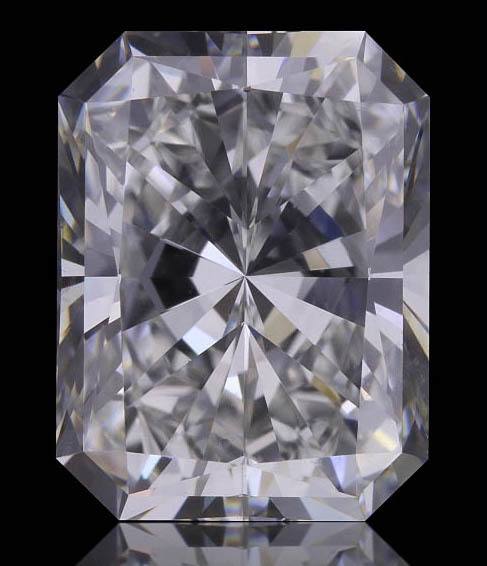
Radiant Cut Diamond
Brilliance: Because cushion cut diamonds have larger facets, they often exhibit less brilliance than radiant cut diamonds. Antique-inspired cushion cut diamonds are even less brilliant. Don’t let this put you off the cushion cut though. In order to make an accurate comparison between two specific radiant vs. cushion cut diamonds, you will need to evaluate them alongside one another.
Cut and Facets: Both the cushion and radiant cut belong to the “brilliant cut” group. Their facets are designed specifically to enhance brilliance. From a normal viewing difference, the most noticeable difference is the face-up outline. Be sure to make this comparison if you are having difficulty choosing between radiant vs. cushion cut diamonds, as there are so many different cushion cut variations.

Cushion Cut Diamond
As you will see when you begin the process of comparing radiant vs. cushion cut diamonds, the differences between the two cuts are not dramatic. Furthermore, because of the availability of a vast diversity of cushion cut modifications, you should compare individual diamonds on a case-by-case basis in order to find the one that suits your personal taste best.
Need help? Call 866-737-0754 to speak with a diamond expert now.
Cushion vs. Radiant Cut Characteristics
Cushion and radiant cut diamonds are among the most popular fancy shapes (fancy shapes are all other shapes besides brilliant round cut diamonds) today. Leading jewelry designers are using radiant and cushion cut diamonds as center stones in many of their diamond engagement rings and diamond jewelry. Although cushion and radiant cut diamonds both emit a lot of fire and brilliance and can come in either square or rectangular orientation, they are two very different cuts. To learn more about their differences and similarities please see below.
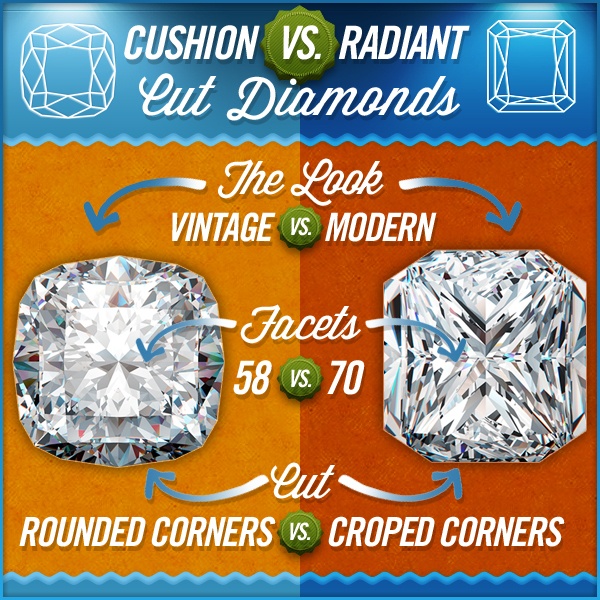
Cushion Cut Diamonds:
Created: In the 1830’s-rooted in mining history.
The Look: Vintage—character-rich antique look.
Number of Facets: 58 facets (can vary)
Shape: Square or rectangular shape with rounded corners and sides, it’s considered by many to be a softer version of the emerald cut. Brilliant-or step-cut faceting infuses the cushion diamond with admirable brilliance
Color: Attracts a lot of color. We recommend no lower than an J color (GIA certified) or G color (EGL certified).
Clarity: With its respected faceting, we recommend no lower than an SI2 (GIA certified) or VS2 (EGL certified).
Carat: Measurements can vary quite a bit from one weight to the next. The emphasis should be placed on the measurements (length x width) rather than the carat weight since that will determine how big the stone will look.
Dimensions: When selecting a square shaped cushion, look for a length-to-width ratio between 1 and 1.05. For those who prefer a rectangular shaped radiant, choose a length-to-width ratio of 1.15 or greater.
Created: Relatively new to the jewelry industry radiant cut diamonds were introduced a little more than 20 years ago.
The Look: Modern; for those who appreciate the fire of round diamonds and the sophistication of emerald-cut or Asscher diamonds will find the radiant cut to be highly desirable.
Number of Facets: 70-facet cut
Shape: A stunning hybrid of a traditional round-cut and an elegant emerald-cut, resulting in a square, near-square, or rectangular orientation with trimmed or cropped corners.
Color: Attracts a lot of color. We recommend no lower than a I color (GIA certified) or G color (EGL certified).
Clarity: With its respected faceting, we recommend no lower than an SI2 (GIA certified) or SI1 (EGL certified).
Carat: Measurements can vary quite a bit from one weight to the next. The emphasis should be placed on the measurements (length x width) rather than the carat weight since that will determine how big the stone will look.
Dimensions: When selecting a square shaped radiant, look for a length-to-width ratio between 1 and 1.05. For those who prefer a rectangular shaped radiant, choose a length-to-width ratio of 1.15 or greater.
Brilliance offers a wide selection of cushion and radiant cut diamonds to fit your style and budget. To begin your custom diamond search go to Brilliance.com or contact us at 866.737.0754 to speak with a diamond and jewelry experts today.

